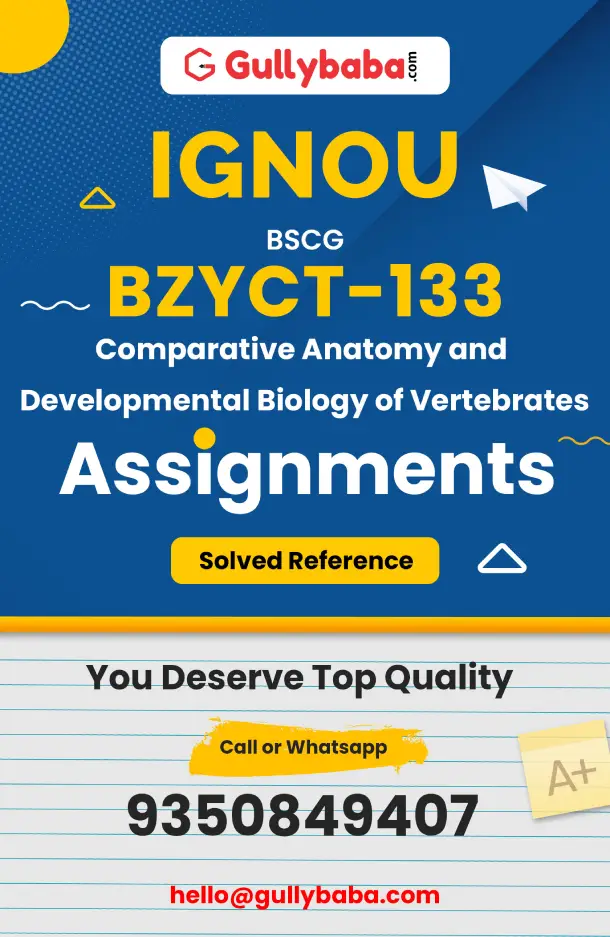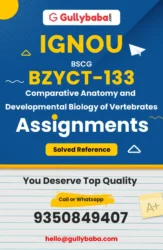PLEASE MATCH YOUR ASSIGNMENT QUESTIONS ACCORDING TO YOUR SESSION
IGNOU BZYCT-133 (January 2025 – December 2025) Assignment Questions
1. a) Explain keratinization in terrestrial vertebrates.
b) Give five features that you can use to distinguish between the skulls of frog and rabbit.
2. a) Explain the major differences between reptilian and avian digestive systems.
b) Describe the structure of the respiratory system of cartilaginous fishes and state how does it differ from that of bony fishes.
3. a) Discuss lymphatic system in different vertebrates.
b) Write short notes on:
i) Blood filteration in kidney
ii) Types of mammalian uteri
4. a) Which part of the brain is well developed in all vertebrates and why?
b) What are pit organs in reptiles? How do vipers and boas locate prey?
5. Briefly write the functions of the following hormones secreted in mammals.
a) Adrenocorticotropic hormone
b) Parathormone
c) Aldosterone
d) Testosterone
e) Progesterone
6. List at least three stages in gene expression that can be regulated to result in differentiated cell types? Explain any one of them with the help of an example.
7. Describe the mechanisms evolved by eggs to prevent polyspermy.
8. Make a flow chart to show the events in metamorphosis.
9. Discuss the process of development of extra embryonic membranes in chick.
10. a) Draw a flow chart to show how the three germinal layers are derived from the zygote.
b) How do genetic
IGNOU BZYCT-133 (January 2024 – December 2024) Assignment Questions
1. a) Write two important differences between scales of reptiles and fishes.
b) Explain keratinization in terrestrial vertebrates.
2. a) Mention the two types of endoskeletal structures found in vertebrates. What is the difference between their ground matrix?
b) Fill in the blanks in the following sentences by selecting an appropriate word from those given in the parenthesis after each sentence:
i) The skeleton of the head is known as ……………………. (vertebral column, pelvic girdle, skull).
ii) Cranium encloses and protects the ……………………… (eye, heart, brain).
iii) The brain within the cranium is in contact with the spinal cord through ………………………… an aperture found at the hind end of the cranium (fenestra ovalis, foramen magnum, external nares).
iv) The vertebra with concavity infront and convexity behind is called …………………. type (amphicoelous, procoelous, opisthocoelous).
v) The bone humerus of the upper arm articulates with the pectoral girdle at ……………………… cavity (glenoid, acetabulum, zygapophysis).
vi) Radio-ulna, a composite bone is found in ……..…………….. (rabbit, bat, frog).
3. a) Describe the structure of the respiratory system of cartilaginous fishes and state how it differs from that of bony fishes.
b) Briefly discuss the mechanism of pulmonary respiration in frog. How is it different from reptilian mechanism of respiration?
4. a) Write short note on the general structure of heart wall.
b) Name different stages in the evolution of heart.
5. Draw a well labeled diagram of the internal structures of ovary and describe the structures present in it.
6. List at least three stages in gene expression that can be regulated to result in differentiated cell types? Explain any one of them with the help of an example.
7. Mark the following statements as ‘True’ or ‘False’:
i) During development cells move by extending their cell processes in all directions without any polarity.
ii) The cytoskeleton of the cell is actively involved in cell movement and cell shape change.
iii) Cadherin on one cell binds strongly to similar cadherins molecules on other cells.
iv) Integrins are cell adhesion molecules that attach cells to other cells at the apical region.
v) Permissive interaction involves gene expression in the induced cell.
vi) Morphogens are paracrine signalling molecules.
vii) In apoptosis the cell organelles are delivered to lysosomes and the cell contents are spilled out.
viii) Cell death by necrosis indicates that cell has undergone a toxic reaction.
ix) Optic cup is induced to form the retinal layers by reciprocal induction from the lens.
x) Pattern formation is the result of morphogenesis.
8. a) Briefly describe the spermiogenesis process.
b) What are the major differences in the development and differentiation of an egg and a sperm?
9. Describe the process of neurulation in chick.
10. a) How is the placenta formed? What are its functions?
b) Draw a flow chart to show how the three germinal layers are derived from the zygote.
IGNOU BZYCT-133 (January 2025 – December 2025) Assignment Questions
1. क) स्थलीय कशेरुकियों में किरैटिनीकरण की प्रक्रिया को समझाइए ।
ख) मेढ़क और खरगोश की करोटि के बीच अन्तर करने के लिए उपयोग की जाने वाली पांच विशेषताएं लिखिए ।
2. क) सरीसृपों तथा पक्षियों के पाचन तंत्रों में मुख्य अंतर क्या हैं, समझाइए ।
ख) उपास्थिमय मछली के श्वसनतंत्र की संरचना का वर्णन कीजिए और बताइए कि ये किस प्रकार अस्थिल मीन के श्वसनतंत्र की संरचना से भिन्न होती हैं ।
3. क) विभिन्न कशेरुकियों में लसीका तंत्र की चर्चा कीजिए ।
ख) निम्न पर लघुटिप्पणी लिखिए :
i) गुर्दो में रक्त निस्पंदन
ii) स्तनधारीय गर्भाशयों के प्रकार
4. क) मस्तिष्क का कौन सा भाग सभी कशेरुकियों में अच्छी तरह से विकसित होता है और क्यों?
ख) सरीसृपों में पिट अंग क्या होते है ? वाइपर और बोआ किस प्रकार शिकार का पता लगाते हैं?
5. स्तनधारियों में निम्नलिखित हॉर्मोनों के कार्यों को संक्षेप में लिखिए:
i) एड्रिनोकॉर्टिकोट्रोपिक हॉर्मोन
ii) पैराथॉर्मोन
iii) आल्डोस्टेरॉन
iv) टेस्टोस्टेरॉन
v) प्रोजेस्टेरॉन
6. जीन अभिव्यक्ति में कम से कम तीन चरण सूचीबद्ध करें जिन्हें विभेदित कोशिका प्रकारों को बनाने के लिए विनियमित किया जा सकता है? एक उदाहरण की सहायता से उनमें से किसी एक की व्याख्या करें।
7. अंडों द्वारा बहुशुक्राणुता को रोकने के लिए विकसित की गई क्रियाविधियों का वर्णन कीजिए ।
8. कायांतरण में घटनाओं को दर्शाने के लिए एक रेखा चित्र (फ्लो चार्ट) बनाएँ।
9. मुर्गी में बाह्य भ्रूणीय झिल्लियों के विकास के प्रक्रम का वर्णन कीजिए ।
10. क) युग्मनज से तीन जनन – स्तरों का बनना एक चार्ट द्वारा दिखाएं ।
ख) आनुवांशिक और पर्यावरणीय दोष किस प्रकार भ्रणीय विकास को प्रभावित करते हैं?
IGNOU BZYCT-133 (January 2024 – December 2024) Assignment Questions
1. क) सरीसृपों तथा मछलियों के शल्कों में दो प्रमुख अंतर बताइए ।
ख) पिच्छों के कौन-कौन से विभिन्न प्रकार होते हैं? इनके क्या-क्या कार्य हैं?
2. क) कशेरूकियों में पाए जाने वाली दो प्रकार की संरचनाओं के नाम लिखिए ।
ख) कोष्ठकों में दिए गए शब्दों में से उपयुक्त शब्द चुनकर निम्न वाक्यों में रिक्त स्थानों की पूर्ति कीजिए :
i) शीर्ष के कंकाल को ………………….. कहा जाता है (कशेरूक दण्ड, श्रोणि मेखला, करोटि ) ।
ii) कपाल के भीतर ……………….. बंद और सुरक्षित रहता / रहती है। (नेत्र, हृदय, मस्तिष्क) ।
iii) कपाल के भीतर स्थित मस्तिष्क कपाल के पिछले सिरे पर बने………………………. नाम छिद्र के माध्यम से मेरू-रज्जु से सम्पर्क बनाए रखता है ( फेनेस्ट्रा ओवैलिस, महारंध्र, बाह्य नासाछिद्र ) ।
iv) जिस कशेरुक में आगे की ओर अवतलता तथा पीछे की ओर उत्तलता होती है उसे …………………. प्रकार का कहते हैं (उभयगर्ती, अग्रगर्ती, पश्चगर्ती) ।
v) उपरिबाहु की हड्डी ह्युमरस अंस मेखला के साथ …………………गुहा पर संधियोजित रहती है (ग्लीनॉइड, ऐसीटैबुलम, जाइगैपोफ़ाइसिस) ।
vi) संयुक्त हड्डी रेडियो- अल्ना …………………. में पायी जाती है। (चूहा, चमगादड़, मेंढ़क) ।
3. क) उपास्थिमय मछली के श्वसनतंत्र की संरचना का वर्णन कीजिए और बताइए कि ये किस प्रकार अस्थिल मीन के श्वसनतंत्र की संरचना से भिन्न होती हैं।
ख) मेंढक में फुफ्फुसीय श्वसन की क्रियाविधि को संक्षेप में लिखिए। यह सरीसृपों के श्वसन की क्रियाविधि से किस प्रकार भिन्न होती है ?
4. क) हृदय की दीवार की सामान्य संरचना पर संक्षिप्त टिप्पणी लिखिए।
ख) हृदय के विकास की मुख्य अवस्थाएं क्या रही हैं, उनके नाम लिखिए ।
5. अंडाशय की आन्तरिक संरचनाओं का स्पष्ट लेबिल युक्त चित्र बनाइए और संरचनाओं का वर्णन कीजिए।
6. जीन अभिव्यक्ति में कम से कम तीन चरण सूचीबद्ध करें जिन्हें विभेदित कोशिका प्रकारों को बनाने के लिए विनियमित किया जा सकता है? एक उदाहरण की सहायता से उनमें से किसी एक की व्याख्या करें।
7. निम्नलिखित कथनों को सत्य’ अथवा ‘असत्य रूप में चिन्हित कीजिए:
i) परिवर्धन के काल में कोशिकाएं अपनी कोशिका प्रवर्गों को सभी दिशाओं में बिना किसी ध्रुवता के विस्तारित करके संचलन करती हैं।
ii) कोशिका का कोशिकाकंकाल, कोशिका संचलन और कोशिका के आकार के परिवर्तन में सक्रिय रूप से भागीदारी करता है।
iii) एक कोशिका पर स्थित कैडेरिन अन्य समान कोशिकाओं पर स्थित कैडेरिन अणुओं से अधिक प्रबलता से बद्ध होते हैं।
iv) इंटीग्रिन कोशिका आसंजन अणु हैं जो शीर्ष क्षेत्र में कोशिकाओं को अन्य कोशिकाओं से संलग्न करते हैं।
v) अनुमयी परस्परक्रिया में प्रेरित कोशिका में जीन अभिव्यक्ति होती है।
vi) मोफजिन पैराक्राइन संकेतन अणु हैं।
vii) एपोप्टोसिन में कोशिका अंगक लाइसोसोमों को भेजे जाते हैं और कोशिका की अंर्तवस्तुएं बाहर निकल जाती हैं।
viii) ऊतकक्षय (नैक्रोसिस) द्वारा कोशिका मृत्यु दर्शाती है कि कोशिका में विषाक्त अभिक्रिया हुई है।
ix) दृक् प्याली लेन्स द्वारा व्युत्क्रमी प्रेरण से रेटीनल परतें बनाने के लिए प्रेरित होती है।
x) पैटर्न निर्माण संरचनाविकास का परिणाम होता है।
8. क) शुक्राणुजनन की क्रिया का संक्षेप में वर्णन कीजिए
ख) अंड और शुक्राणु के परिवर्धन और विभेदन में क्या प्रमुख अन्तर होते हैं?
9. मुर्गी में तंत्रिकाभवन की प्रक्रिया का वर्णन कीजिए ।
10. क) अपरा कैसे बनती है? इसके क्या कार्य हैं।
ख) युग्मनज से तीन जनन स्तरों के निर्माण को एक चार्ट द्वारा दिखाएं।










